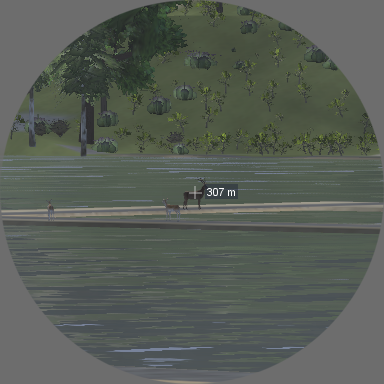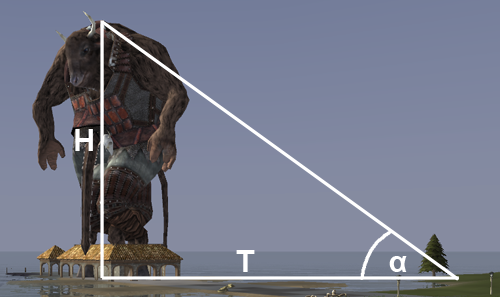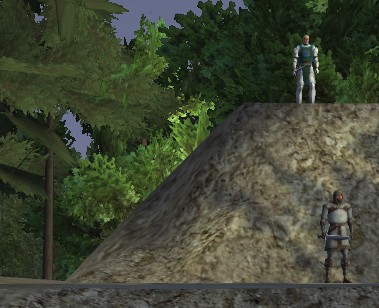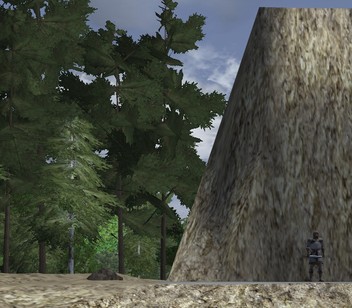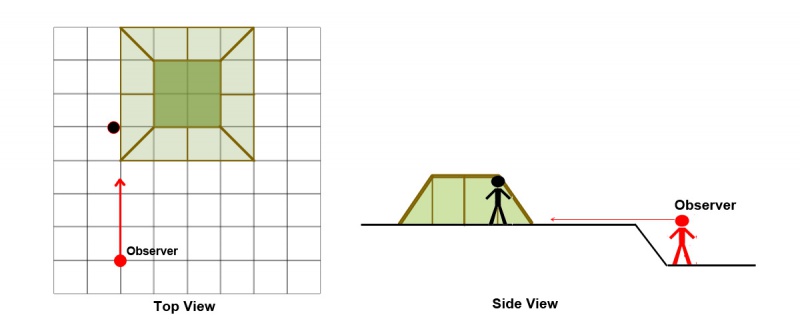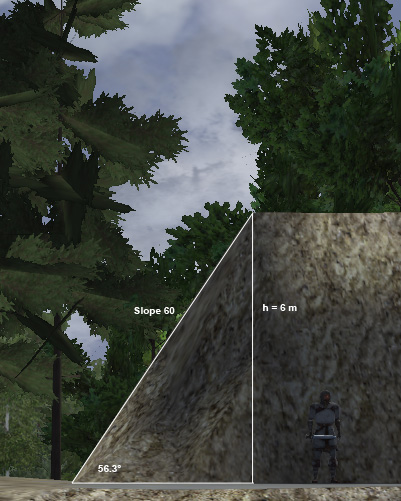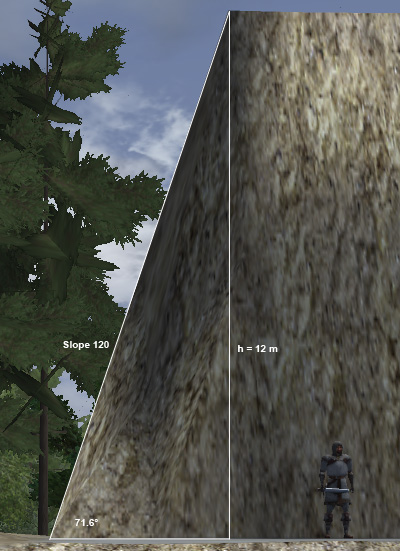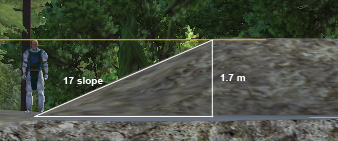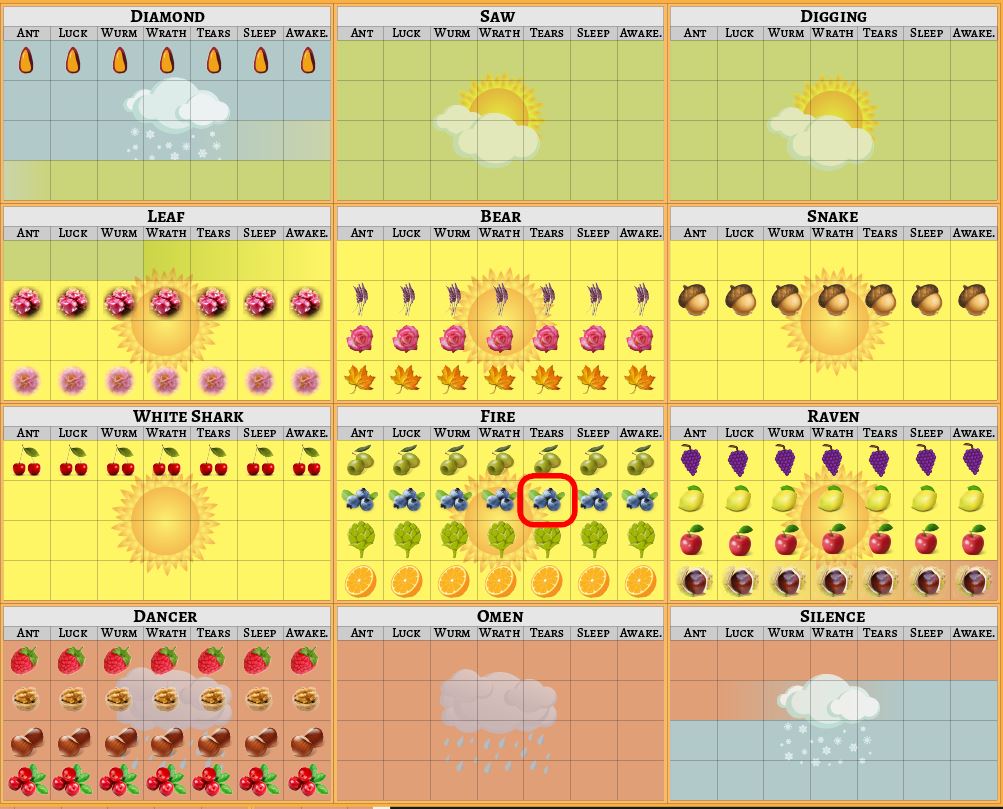Difference between revisions of "Wurm Universe"
(Added a list of Wurm seasons) |
|||
| (52 intermediate revisions by 13 users not shown) | |||
| Line 1: | Line 1: | ||
| − | '' | + | [[CDB|Main]] / [[:Category:Wurm universe|Wurm Universe]] / '''{{PAGENAME}}''' |
| − | |||
| − | |||
| − | The | + | '''This page provides a rundown of the physics of the Wurm world. Below are sections individually designated to the various elements of these physics.''' |
| + | |||
| + | == Quick References == | ||
| + | |||
| + | === Measurements === | ||
| + | |||
| + | * 1 tile = 4 meter x 4 meter square. | ||
| + | |||
| + | * 250 tiles = 1 kilometer | ||
| + | |||
| + | * 10 dirts (dropped or dug) = 1 meter of slope | ||
| + | |||
| + | === Time === | ||
| + | |||
| + | * 1 RL hour = 8 Wurm hours | ||
| + | |||
| + | * 1 RL day = 8 Wurm days | ||
| + | |||
| + | * 1 Wurm day = 3 real hours | ||
| + | |||
| + | * 1 Wurm hour = 7.5 real minutes (0.125 real hours) | ||
| + | |||
| + | * 1 Wurm year = 336 Wurm days = 42 real days | ||
| + | |||
| + | == Distance, Slopes, and Height == | ||
| + | |||
| + | * The standard measurement designated to measuring distance in Wurm is the “tile”. Tiles are the equally sized squares that the landscape of Wurm Online is entirely composed of. In the 3D world of Wurm a tile can be either flat or inclined, so that one or more of its corners can be higher or lower than the others. | ||
| − | + | * A relatively flat tile represents what in real-life would be a 4 meter by 4 meter square. Subsequently, 250 tiles then equals what would be, in real-life, 1 kilometer. | |
| − | |||
| − | |||
| − | + | * Exact linear distance can easily be gleaned by using a [[spyglass]], as this tool will display the exact distance between the user and any distant object targeted within its viewing crosshairs. See picture for example: | |
[[File:Spyglass.png]] | [[File:Spyglass.png]] | ||
| − | + | However, when it comes to measuring heights and slopes, the spyglass is not quite accurate enough to always yield reliable results. Triangulation is thus recommended in such situations: | |
[[File:Triangulation.png]] | [[File:Triangulation.png]] | ||
| − | To determine the height H of an object, you define a reference point, take a screenshot (as shown in the example) and measure the angle α between the ground and the top of the object, as seen from the reference point. | + | To use triangulation to determine the height (H) of an object, you must first define a reference point. To do so, take a screenshot (as shown in the example) and measure the angle (α) between the ground and the top of the object, as seen from the reference point. As we have no means to measure angles in-game, we need to use a graphics program to determine the angle on the screenshot. Additionally you need to measure the horizontal distance, which you obtain by counting the number of tiles T (remember: one tile corresponds to a distance of 4 meters). You then get the height H by using this formula: |
'''H = T tan α''' | '''H = T tan α''' | ||
| Line 28: | Line 50: | ||
(Please note that the result has to be rounded, due to the immanent inaccuracy of this method.) Here is a list of heights for some arbitrary objects, just to give some examples: | (Please note that the result has to be rounded, due to the immanent inaccuracy of this method.) Here is a list of heights for some arbitrary objects, just to give some examples: | ||
| − | {| | + | {| class="wikitable" |
| − | ! style="text-align: | + | ! style="font-weight: bold; text-align: center;" width="200" | Object |
| − | ! Height (m) | + | ! style="font-weight: bold; text-align: center;" width="100" | Height (m) |
| + | |- | ||
| + | | Player character | ||
| + | | style="text-align: right;" | 1.7 | ||
|- | |- | ||
| − | | | + | |House wall (one level) |
| − | | | + | | style="text-align: right;" | 3 * |
|- | |- | ||
| − | | | + | |Standard mine tunnel |
| − | | | + | | style="text-align: right;" | 3 |
|- | |- | ||
|Pillar | |Pillar | ||
| − | | | + | | style="text-align: right;" | 5.6 |
|- | |- | ||
|Freedom tower (incl. flag) | |Freedom tower (incl. flag) | ||
| − | | | + | | style="text-align: right;" | 25 |
|- | |- | ||
|Colossus | |Colossus | ||
| − | | | + | | style="text-align: right;" | 34 |
|- | |- | ||
|Deity avatar | |Deity avatar | ||
| − | | | + | | style="text-align: right;" | 40 |
| − | |} | + | |}''(*) Note: floors are 0.3m over walls (example standing on 2nd floor is at 3m + 0.3m = 3.3m) |
| − | + | * Finally, talking about measuring heights, we must look at another basic unit of measurement used in the Wurm world: “dirts”. Whenever we see sloped tiles defining the 3D landscape, the elevation of slopes is given in terms of the amount of “dirts" dropped. When terraforming the land you use a shovel to dig or drop dirt - you add or subtract one “unit of dirt” with each action of the shovel. | |
| − | |||
| − | Finally, talking about measuring heights, we must look at another basic unit of measurement used in the Wurm | ||
| − | Using the method of triangulation described above we can find out how these “units of dirt” correspond to metric units. By dropping dirt we make elevated platforms of various heights | + | * Using the method of triangulation described above, we can find out how these “units of dirt” correspond to metric units. By dropping dirt, we make elevated platforms of various heights thus creating different slopes. We then position an observer in a pit, so that the eye level is slightly above the ground, and take screenshots: |
[[File:Slope04raw.jpg]] ..... [[File:Slope120raw.jpg]] | [[File:Slope04raw.jpg]] ..... [[File:Slope120raw.jpg]] | ||
| Line 65: | Line 88: | ||
[[File:Slope060_annotated.jpg]] ..... [[File:Slope120_annotated.jpg]] | [[File:Slope060_annotated.jpg]] ..... [[File:Slope120_annotated.jpg]] | ||
| − | + | This table shows the angle for slopes spanning a single tile): | |
| − | {| | + | {| class="wikitable" |
| − | ! style="text-align: | + | ! style="font-weight: bold; text-align: center;" width="100" | Slope |
| − | ! Angle | + | ! style="font-weight: bold; text-align: center;" width="100" | Angle |
| − | ! Elevation (m) | + | ! style="font-weight: bold; text-align: center;" width="100" | Elevation (m) |
|- | |- | ||
| − | |10 | + | | style="text-align: right;" | 10 |
| − | |14.0 | + | | style="text-align: right;" | 14.0 |
| − | |1.0 | + | | style="text-align: right;" | 1.0 |
|- | |- | ||
| − | |20 | + | | style="text-align: right;" | 20 |
| − | |26.6 | + | | style="text-align: right;" | 26.6 |
| − | |2.0 | + | | style="text-align: right;" | 2.0 |
|- | |- | ||
| − | |30 | + | | style="text-align: right;" | 30 |
| − | |36.9 | + | | style="text-align: right;" | 36.9 |
| − | |3.0 | + | | style="text-align: right;" | 3.0 |
|- | |- | ||
| − | |40 | + | | style="text-align: right;" | 40 |
| − | |45.0 | + | | style="text-align: right;" | 45.0 |
| − | |4.0 | + | | style="text-align: right;" | 4.0 |
|- | |- | ||
| − | |50 | + | | style="text-align: right;" | 50 |
| − | |51.3 | + | | style="text-align: right;" | 51.3 |
| − | |5.0 | + | | style="text-align: right;" | 5.0 |
|- | |- | ||
| − | |60 | + | | style="text-align: right;" | 60 |
| − | |56.3 | + | | style="text-align: right;" | 56.3 |
| − | |6.0 | + | | style="text-align: right;" | 6.0 |
|- | |- | ||
| − | |70 | + | | style="text-align: right;" | 70 |
| − | |60.3 | + | | style="text-align: right;" | 60.3 |
| − | |7.0 | + | | style="text-align: right;" | 7.0 |
|- | |- | ||
| − | |80 | + | | style="text-align: right;" | 80 |
| − | |63.4 | + | | style="text-align: right;" | 63.4 |
| − | |8.0 | + | | style="text-align: right;" | 8.0 |
|- | |- | ||
| − | |90 | + | | style="text-align: right;" | 90 |
| − | |66.0 | + | | style="text-align: right;" | 66.0 |
| − | |9.0 | + | | style="text-align: right;" | 9.0 |
|- | |- | ||
| − | |100 | + | | style="text-align: right;" | 100 |
| − | |68.2 | + | | style="text-align: right;" | 68.2 |
| − | |10.0 | + | | style="text-align: right;" | 10.0 |
|- | |- | ||
| − | |150 | + | | style="text-align: right;" | 150 |
| − | |75.1 | + | | style="text-align: right;" | 75.1 |
| − | |15.0 | + | | style="text-align: right;" | 15.0 |
|- | |- | ||
| − | |200 | + | | style="text-align: right;" | 200 |
| − | |78.7 | + | | style="text-align: right;" | 78.7 |
| − | |20.0 | + | | style="text-align: right;" | 20.0 |
|} | |} | ||
| Line 125: | Line 148: | ||
'''1 meter = 10 dirts.''' | '''1 meter = 10 dirts.''' | ||
| − | Using this method it is also possible to determine the height of a player character with sufficient accuracy: | + | Using this method, it is also possible to determine the height of a player character with sufficient accuracy: |
[[File:CharacterPerspective.jpg]] | [[File:CharacterPerspective.jpg]] | ||
| + | ---- | ||
| − | - | + | == Volume == |
| + | |||
| + | Volume is a measurement of how much space an item takes up. This measure is often not displayed in-game. Bulk bins are the one exception. | ||
| + | |||
| + | More Notes on Volume in Wurm: | ||
| + | |||
| + | * Liquids happen to be 1kg to 1L (weight to volume), and because of this, are often referenced in liters (L). Many solid items have different kg to L relationships. Examples: | ||
| + | ** A small bucket can hold 12 L. A full bucket of water contains 12 L of water weighting 12 kg. | ||
| + | ** A pottery bowl can hold 9 L and weights 0.50 kg. A fillet of fish is 0.20 L and weights 0.30 kg. Thus, a pottery bowl can hold 45 fillets (9 / 0.2 = 45) and will weight 14 kg (13.50 kg fillet, 0.50 kg bowl). | ||
| − | + | * Volume puts limits on how much of something can fit in a container. All containers themselves consume slightly more volume then they hold. Hypothetically then, players can carry infinite volume and containers can hold infinite weight. | |
| − | + | * You can calculate how many of an item will fit in a container by dividing the container's volume by the stored item's volume. See the [[Container]] page for a list of containers and volume capacities. | |
| − | + | == Time, Seasons == | |
| − | + | * The world of Wurm rotates rapidly around its axis: approximately 8 times faster than the real-life Earth. As a result, the following statements are true: | |
| − | |||
| − | |||
| − | '''1 real | + | '''1 real day = 8 Wurm days''' AND '''1 Wurm day = 3 real hours''' |
| − | + | '''1 real hour = 8 Wurm hours''' AND '''1 Wurm hour = 0.125 real hours (7.5 real minutes)''' | |
| − | + | * For more help with time, see the following '''Game Time Conversion Table''': | |
| − | + | {| class="wikitable" | |
| − | + | ! colspan="6" style="font-weight: bold;" | Real | |
| − | + | ! colspan="6" style="font-weight: bold;" | Wurm | |
| + | |- | ||
| + | | style="font-weight: bold; text-align: center;" width="100" | Minutes | ||
| + | | style="font-weight: bold; text-align: center;" width="100" | Hours | ||
| + | | style="font-weight: bold; text-align: center;" width="100" | Days | ||
| + | | style="font-weight: bold; text-align: center;" width="100" | Weeks | ||
| + | | style="font-weight: bold; text-align: center;" width="100" | Months | ||
| + | | style="font-weight: bold; text-align: center;" width="100" | Years | ||
| + | | style="font-weight: bold; text-align: center;" width="100" | Minutes | ||
| + | | style="font-weight: bold; text-align: center;" width="100" | Hours | ||
| + | | style="font-weight: bold; text-align: center;" width="100" | Days | ||
| + | | style="font-weight: bold; text-align: center;" width="100" | Weeks | ||
| + | | style="font-weight: bold; text-align: center;" width="100" | Months | ||
| + | | style="font-weight: bold; text-align: center;" width="100" | Years | ||
| + | |- | ||
| + | | style="text-align: right; font-weight: bold;" | 1.00 | ||
| + | | style="text-align: right;" | 0.02 | ||
| + | | style="text-align: right;" | 0.00 | ||
| + | | style="text-align: right;" | 0.00 | ||
| + | | style="text-align: right;" | 0.00 | ||
| + | | style="text-align: right;" | 0.00 | ||
| + | | style="text-align: right;" | 8.00 | ||
| + | | style="text-align: right;" | 0.13 | ||
| + | | style="text-align: right;" | 0.01 | ||
| + | | style="text-align: right;" | 0.00 | ||
| + | | style="text-align: right;" | 0.00 | ||
| + | | style="text-align: right;" | 0.00 | ||
| + | |- | ||
| + | | style="text-align: right;" | 60.00 | ||
| + | | style="text-align: right; font-weight: bold;" | 1.00 | ||
| + | | style="text-align: right;" | 0.04 | ||
| + | | style="text-align: right;" | 0.01 | ||
| + | | style="text-align: right;" | 0.00 | ||
| + | | style="text-align: right;" | 0.00 | ||
| + | | style="text-align: right;" | 480.00 | ||
| + | | style="text-align: right;" | 8.00 | ||
| + | | style="text-align: right;" | 0.33 | ||
| + | | style="text-align: right;" | 0.05 | ||
| + | | style="text-align: right;" | 0.01 | ||
| + | | style="text-align: right;" | 0.00 | ||
| + | |- | ||
| + | | style="text-align: right;" | 1,440.00 | ||
| + | | style="text-align: right;" | 24.00 | ||
| + | | style="text-align: right; font-weight: bold;" | 1.00 | ||
| + | | style="text-align: right;" | 0.14 | ||
| + | | style="text-align: right;" | 0.03 | ||
| + | | style="text-align: right;" | 0.00 | ||
| + | | style="text-align: right;" | 11,520.00 | ||
| + | | style="text-align: right;" | 192.00 | ||
| + | | style="text-align: right;" | 8.00 | ||
| + | | style="text-align: right;" | 1.14 | ||
| + | | style="text-align: right;" | 0.25 | ||
| + | | style="text-align: right;" | 0.02 | ||
| + | |- | ||
| + | | style="text-align: right;" | 10,080.00 | ||
| + | | style="text-align: right;" | 168.00 | ||
| + | | style="text-align: right;" | 7.00 | ||
| + | | style="text-align: right; font-weight: bold;" | 1.00 | ||
| + | | style="text-align: right;" | 0.23 | ||
| + | | style="text-align: right;" | 0.02 | ||
| + | | style="text-align: right;" | 80,640.00 | ||
| + | | style="text-align: right;" | 1,344.00 | ||
| + | | style="text-align: right;" | 56.00 | ||
| + | | style="text-align: right;" | 8.00 | ||
| + | | style="text-align: right;" | 1.92 | ||
| + | | style="text-align: right;" | 0.16 | ||
| + | |- | ||
| + | | style="text-align: right;" | 43,829.10 | ||
| + | | style="text-align: right;" | 730.49 | ||
| + | | style="text-align: right;" | 30.44 | ||
| + | | style="text-align: right;" | 4.35 | ||
| + | | style="text-align: right; font-weight: bold;" | 1.00 | ||
| + | | style="text-align: right;" | 0.08 | ||
| + | | style="text-align: right;" | 350,632.80 | ||
| + | | style="text-align: right;" | 5,843.88 | ||
| + | | style="text-align: right;" | 243.50 | ||
| + | | style="text-align: right;" | 34.79 | ||
| + | | style="text-align: right;" | 8.76 | ||
| + | | style="text-align: right;" | 0.73 | ||
| + | |- | ||
| + | | style="text-align: right;" | 525,949.00 | ||
| + | | style="text-align: right;" | 8,765.82 | ||
| + | | style="text-align: right;" | 365.24 | ||
| + | | style="text-align: right;" | 52.18 | ||
| + | | style="text-align: right;" | 12.00 | ||
| + | | style="text-align: right; font-weight: bold;" | 1.00 | ||
| + | | style="text-align: right;" | 4,207,592.00 | ||
| + | | style="text-align: right;" | 70,126.53 | ||
| + | | style="text-align: right;" | 2,921.94 | ||
| + | | style="text-align: right;" | 417.42 | ||
| + | | style="text-align: right;" | 104.40 | ||
| + | | style="text-align: right;" | 8.70 | ||
| + | |- | ||
| + | | style="text-align: right;" | 0.13 | ||
| + | | style="text-align: right;" | 0.00 | ||
| + | | style="text-align: right;" | 0.00 | ||
| + | | style="text-align: right;" | 0.00 | ||
| + | | style="text-align: right;" | 0.00 | ||
| + | | style="text-align: right;" | 0.00 | ||
| + | | style="text-align: right; font-weight: bold;" | 1.00 | ||
| + | | style="text-align: right;" | 0.02 | ||
| + | | style="text-align: right;" | 0.00 | ||
| + | | style="text-align: right;" | 0.00 | ||
| + | | style="text-align: right;" | 0.00 | ||
| + | | style="text-align: right;" | 0.00 | ||
| + | |- | ||
| + | | style="text-align: right;" | 7.50 | ||
| + | | style="text-align: right;" | 0.13 | ||
| + | | style="text-align: right;" | 0.01 | ||
| + | | style="text-align: right;" | 0.00 | ||
| + | | style="text-align: right;" | 0.00 | ||
| + | | style="text-align: right;" | 0.00 | ||
| + | | style="text-align: right;" | 60.00 | ||
| + | | style="text-align: right; font-weight: bold;" | 1.00 | ||
| + | | style="text-align: right;" | 0.04 | ||
| + | | style="text-align: right;" | 0.01 | ||
| + | | style="text-align: right;" | 0.00 | ||
| + | | style="text-align: right;" | 0.00 | ||
| + | |- | ||
| + | | style="text-align: right;" | 180.00 | ||
| + | | style="text-align: right;" | 3.00 | ||
| + | | style="text-align: right;" | 0.13 | ||
| + | | style="text-align: right;" | 0.02 | ||
| + | | style="text-align: right;" | 0.00 | ||
| + | | style="text-align: right;" | 0.00 | ||
| + | | style="text-align: right;" | 1,440.00 | ||
| + | | style="text-align: right;" | 24.00 | ||
| + | | style="text-align: right; font-weight: bold;" | 1.00 | ||
| + | | style="text-align: right;" | 0.14 | ||
| + | | style="text-align: right;" | 0.04 | ||
| + | | style="text-align: right;" | 0.00 | ||
| + | |- | ||
| + | | style="text-align: right;" | 1,260.00 | ||
| + | | style="text-align: right;" | 21.00 | ||
| + | | style="text-align: right;" | 0.88 | ||
| + | | style="text-align: right;" | 0.13 | ||
| + | | style="text-align: right;" | 0.03 | ||
| + | | style="text-align: right;" | 0.00 | ||
| + | | style="text-align: right;" | 10,080.00 | ||
| + | | style="text-align: right;" | 168.00 | ||
| + | | style="text-align: right;" | 7.00 | ||
| + | | style="text-align: right; font-weight: bold;" | 1.00 | ||
| + | | style="text-align: right;" | 0.25 | ||
| + | | style="text-align: right;" | 0.02 | ||
| + | |- | ||
| + | | style="text-align: right;" | 5,040.00 | ||
| + | | style="text-align: right;" | 84.00 | ||
| + | | style="text-align: right;" | 3.50 | ||
| + | | style="text-align: right;" | 0.50 | ||
| + | | style="text-align: right;" | 0.11 | ||
| + | | style="text-align: right;" | 0.01 | ||
| + | | style="text-align: right;" | 40,320.00 | ||
| + | | style="text-align: right;" | 672.00 | ||
| + | | style="text-align: right;" | 28.00 | ||
| + | | style="text-align: right;" | 4.00 | ||
| + | | style="text-align: right; font-weight: bold;" | 1.00 | ||
| + | | style="text-align: right;" | 0.08 | ||
| + | |- | ||
| + | | style="text-align: right;" | 60,480.00 | ||
| + | | style="text-align: right;" | 1,008.00 | ||
| + | | style="text-align: right;" | 42.00 | ||
| + | | style="text-align: right;" | 6.00 | ||
| + | | style="text-align: right;" | 1.37 | ||
| + | | style="text-align: right;" | 0.11 | ||
| + | | style="text-align: right;" | 483,840.00 | ||
| + | | style="text-align: right;" | 8,064.00 | ||
| + | | style="text-align: right;" | 336.00 | ||
| + | | style="text-align: right;" | 48.00 | ||
| + | | style="text-align: right;" | 12.00 | ||
| + | | style="text-align: right; font-weight: bold;" | 1.00 | ||
| + | |} | ||
| − | + | * Typing /time ingame will give you the current time stamp, as well as the day/week/starfall and year. For example: "It is 14:07:12 on Luck day in week 2 of the starfall of the Leaf in the year of 1129." | |
| + | * Time of day is defined as follows: Morning (4:30-10:30) | Afternoon (10:30-16:30) | Evening (16:30-22:30) | Night (22:30-4:30). | ||
| − | + | * The Wurm world also experiences 4 different seasons called “winter”, “spring”, “summer”, and “autumn”. These seasons reoccur regularly during 336 Wurm days. As such: | |
'''1 Wurm year = 336 Wurm days = 42 real days.''' | '''1 Wurm year = 336 Wurm days = 42 real days.''' | ||
| − | This is a convenient number, because 336 = 7 x 4 x 12, allowing us to split a Wurm year into 12 months (called “starfalls”), each with 4 weeks of 7 days. | + | * This is a convenient number, because 336 = 7 x 4 x 12, allowing us to split a Wurm year into 12 months (called “starfalls”), each with 4 weeks of 7 days. As such: |
'''1 Wurm year = 12 starfalls | '''1 Wurm year = 12 starfalls | ||
| Line 164: | Line 365: | ||
1 Wurm week = 7 Wurm days = 21 real hours.''' | 1 Wurm week = 7 Wurm days = 21 real hours.''' | ||
| − | |||
| − | + | ===The 12 Starfalls and Associated Harvest Seasons=== | |
| − | + | ||
| − | + | # Diamonds Starfall - ''[[Pinenut]] (week 1)'' | |
| − | + | # Saw Starfall - ''No seasons'' | |
| − | * | + | # Digging Starfall - ''No seasons'' |
| − | + | # Leaf Starfall - [[Oleander]] (week 2)'', ''[[Camellia]] (week 4), | |
| − | + | # Bear starfall - [[Lavender flowers]] (week 2), [[Rose flowers]] (week 3), [[Maple]] (week 4)'' | |
| + | # Snake starfall - ''[[Acorns]] (week 2)'' | ||
| + | # White Shark starfall - ''[[Cherry]] (week 1)'' | ||
| + | # Fire Starfall - ''[[Olive]] (week 1), ''[[Blueberries]] (week 2)'', [[Hops]] (week 3)'', [[Orange]] (week 4)'' | ||
| + | # Raven starfall - ''[[Grape]] (week 1), ''[[Lemon]] (week 2), [[Apple]] (week 3)'', ''[[Chestnuts]] season (week 4)'' | ||
| + | # Dancer Starfall - ''[[Raspberries]] season (week 1)'', ''[[Walnuts]] (week 2), [[Hazelnuts]] (week 3)'', ''[[Lingonberries]] season (week 4)'' | ||
| + | # Omen Starfall - ''No seasons'' | ||
| + | # Silent Starfall - ''No seasons'' | ||
| + | |||
| + | *''Please note: The actual season for harvest can be -/+ 2 weeks. Also any day (and any minute in that day) in that week.'' | ||
| + | |||
| + | Also see: [[Harvest calendar]] for more information. | ||
| + | |||
| + | |||
| + | ===Weekdays (7)=== | ||
| − | + | # Day of the Ant | |
| + | # Day of Luck | ||
| + | # Day of the Wurm | ||
| + | # Day of Wrath | ||
| + | # Day of Tears | ||
| + | # Day of Sleep | ||
| + | # Day of Awakening | ||
| − | + | ===Seasons=== | |
| − | |||
| − | |||
| − | |||
| − | |||
| − | |||
| − | |||
| − | |||
| − | |||
| − | |||
| − | |||
| − | |||
| − | + | The Wurm year has 4 seasons: | |
# '''Spring''' (beginning in week 3 of the Diamond Starfall) | # '''Spring''' (beginning in week 3 of the Diamond Starfall) | ||
| Line 199: | Line 408: | ||
This is the Wurm calendar, showing days, weeks, starfalls, and the seasons: | This is the Wurm calendar, showing days, weeks, starfalls, and the seasons: | ||
| − | [[File:Wurm | + | (''Please note: The actual season for harvest can be -/+ 2 Wurm weeks. Also any day (and any minute in that day) in that week.'') |
| + | |||
| + | [[File:wurmcalendar.JPG]] | ||
| + | |||
| + | (Image taken from Yaga's "WurmClock V3", by courtesy of [http://www.wurmpedia.com/index.php/Player:Yaga Yaga].) | ||
| + | |||
| + | ==Weather/Meteorology== | ||
| + | |||
| + | Having 4 seasons (as noted above) means a lot of weather changes. There is no patterns to the weather other than snow is only during winter. Wind is also unpredictable but seems to follow the same direction on multiple servers. The time span for wind changes also varies. | ||
| + | |||
| + | *'''[[Wind]]''' only affects the speed of boats, and can help or hurt the speed depending on whether the boat is sailing with or against the current [[wind]] direction. | ||
| + | :* To find the current [[wind]] direction '''in-game''', type /weather into a chat window. This current [[wind]] is also displayed in [https://discord.com/channels/202801255024689153/845376777278717972/1189613830679052308 this perpetual message] in the server-status channel of the '''official Wurm Online Discord server''' | ||
| + | |||
| + | *'''[[Rain]]''' does not impact the water level, but can result in rainbows. | ||
| + | :* With [[Sorcery]], [[rain]] can be summoned using the Lightning spell | ||
| + | :* Burn times of outdoor furnaces are reduced when it rains, but the exact amount is unknown. | ||
| + | *'''Lightning''' can strike during rain and also has unique effects if a player is struck by it: | ||
| + | :* The following message appears in the player's event tab: ''YOU ARE HIT BY LIGHTNING! OUCH! A strange dizziness runs through your head, eventually sharpening your senses.'' | ||
| + | :* Mind speed increases drastically (3.0+), but all equipped armor/weapons take 20 damage. | ||
| + | :* The chance of getting hit is very low. | ||
| + | ::*0.000024% chance on 2k servers (Deliverance, Exodus, Pristine, Release) | ||
| + | ::*0.000006% chance on 4k servers (Independence) | ||
| + | ::*0.0000015% chance on 8k servers (Xanadu) | ||
| + | |||
| + | *'''Snow''' changes the visual terrain to white. Its main purpose is to make [[snowball]]s to throw or use in a [[larder]] to keep food from decaying as fast. | ||
| + | |||
| + | *'''[[Fog]]''' was rumored to be predicted by [[fog spider]]s, but they do spawn during this time. [[Fog]] levels, unlike wind, is specific to each server. | ||
| + | |||
| + | *'''Day/Night''' only affects visual brightness, not potential weather effects. | ||
| + | |||
| + | [[Category:Wurm universe]] | ||
Latest revision as of 01:12, 26 August 2024
Main / Wurm Universe / Wurm Universe
This page provides a rundown of the physics of the Wurm world. Below are sections individually designated to the various elements of these physics.
Contents
Quick References
Measurements
- 1 tile = 4 meter x 4 meter square.
- 250 tiles = 1 kilometer
- 10 dirts (dropped or dug) = 1 meter of slope
Time
- 1 RL hour = 8 Wurm hours
- 1 RL day = 8 Wurm days
- 1 Wurm day = 3 real hours
- 1 Wurm hour = 7.5 real minutes (0.125 real hours)
- 1 Wurm year = 336 Wurm days = 42 real days
Distance, Slopes, and Height
- The standard measurement designated to measuring distance in Wurm is the “tile”. Tiles are the equally sized squares that the landscape of Wurm Online is entirely composed of. In the 3D world of Wurm a tile can be either flat or inclined, so that one or more of its corners can be higher or lower than the others.
- A relatively flat tile represents what in real-life would be a 4 meter by 4 meter square. Subsequently, 250 tiles then equals what would be, in real-life, 1 kilometer.
- Exact linear distance can easily be gleaned by using a spyglass, as this tool will display the exact distance between the user and any distant object targeted within its viewing crosshairs. See picture for example:
However, when it comes to measuring heights and slopes, the spyglass is not quite accurate enough to always yield reliable results. Triangulation is thus recommended in such situations:
To use triangulation to determine the height (H) of an object, you must first define a reference point. To do so, take a screenshot (as shown in the example) and measure the angle (α) between the ground and the top of the object, as seen from the reference point. As we have no means to measure angles in-game, we need to use a graphics program to determine the angle on the screenshot. Additionally you need to measure the horizontal distance, which you obtain by counting the number of tiles T (remember: one tile corresponds to a distance of 4 meters). You then get the height H by using this formula:
H = T tan α
Here is an example: For a distance of 40 tiles (T=160m) we measure an angle of 14°. Thus, our avatar of Magranon would have a height of:
H = 160m ● tan(14°) = 40m
(Please note that the result has to be rounded, due to the immanent inaccuracy of this method.) Here is a list of heights for some arbitrary objects, just to give some examples:
| Object | Height (m) |
|---|---|
| Player character | 1.7 |
| House wall (one level) | 3 * |
| Standard mine tunnel | 3 |
| Pillar | 5.6 |
| Freedom tower (incl. flag) | 25 |
| Colossus | 34 |
| Deity avatar | 40 |
(*) Note: floors are 0.3m over walls (example standing on 2nd floor is at 3m + 0.3m = 3.3m)
- Finally, talking about measuring heights, we must look at another basic unit of measurement used in the Wurm world: “dirts”. Whenever we see sloped tiles defining the 3D landscape, the elevation of slopes is given in terms of the amount of “dirts" dropped. When terraforming the land you use a shovel to dig or drop dirt - you add or subtract one “unit of dirt” with each action of the shovel.
- Using the method of triangulation described above, we can find out how these “units of dirt” correspond to metric units. By dropping dirt, we make elevated platforms of various heights thus creating different slopes. We then position an observer in a pit, so that the eye level is slightly above the ground, and take screenshots:
Measuring the angles and using the formula given above, we can triangulate the elevation of the platform:
This table shows the angle for slopes spanning a single tile):
| Slope | Angle | Elevation (m) |
|---|---|---|
| 10 | 14.0 | 1.0 |
| 20 | 26.6 | 2.0 |
| 30 | 36.9 | 3.0 |
| 40 | 45.0 | 4.0 |
| 50 | 51.3 | 5.0 |
| 60 | 56.3 | 6.0 |
| 70 | 60.3 | 7.0 |
| 80 | 63.4 | 8.0 |
| 90 | 66.0 | 9.0 |
| 100 | 68.2 | 10.0 |
| 150 | 75.1 | 15.0 |
| 200 | 78.7 | 20.0 |
Thus, there is a simple relation between “dirts” and metric units:
1 meter = 10 dirts.
Using this method, it is also possible to determine the height of a player character with sufficient accuracy:
Volume
Volume is a measurement of how much space an item takes up. This measure is often not displayed in-game. Bulk bins are the one exception.
More Notes on Volume in Wurm:
- Liquids happen to be 1kg to 1L (weight to volume), and because of this, are often referenced in liters (L). Many solid items have different kg to L relationships. Examples:
- A small bucket can hold 12 L. A full bucket of water contains 12 L of water weighting 12 kg.
- A pottery bowl can hold 9 L and weights 0.50 kg. A fillet of fish is 0.20 L and weights 0.30 kg. Thus, a pottery bowl can hold 45 fillets (9 / 0.2 = 45) and will weight 14 kg (13.50 kg fillet, 0.50 kg bowl).
- Volume puts limits on how much of something can fit in a container. All containers themselves consume slightly more volume then they hold. Hypothetically then, players can carry infinite volume and containers can hold infinite weight.
- You can calculate how many of an item will fit in a container by dividing the container's volume by the stored item's volume. See the Container page for a list of containers and volume capacities.
Time, Seasons
- The world of Wurm rotates rapidly around its axis: approximately 8 times faster than the real-life Earth. As a result, the following statements are true:
1 real day = 8 Wurm days AND 1 Wurm day = 3 real hours
1 real hour = 8 Wurm hours AND 1 Wurm hour = 0.125 real hours (7.5 real minutes)
- For more help with time, see the following Game Time Conversion Table:
| Real | Wurm | ||||||||||
|---|---|---|---|---|---|---|---|---|---|---|---|
| Minutes | Hours | Days | Weeks | Months | Years | Minutes | Hours | Days | Weeks | Months | Years |
| 1.00 | 0.02 | 0.00 | 0.00 | 0.00 | 0.00 | 8.00 | 0.13 | 0.01 | 0.00 | 0.00 | 0.00 |
| 60.00 | 1.00 | 0.04 | 0.01 | 0.00 | 0.00 | 480.00 | 8.00 | 0.33 | 0.05 | 0.01 | 0.00 |
| 1,440.00 | 24.00 | 1.00 | 0.14 | 0.03 | 0.00 | 11,520.00 | 192.00 | 8.00 | 1.14 | 0.25 | 0.02 |
| 10,080.00 | 168.00 | 7.00 | 1.00 | 0.23 | 0.02 | 80,640.00 | 1,344.00 | 56.00 | 8.00 | 1.92 | 0.16 |
| 43,829.10 | 730.49 | 30.44 | 4.35 | 1.00 | 0.08 | 350,632.80 | 5,843.88 | 243.50 | 34.79 | 8.76 | 0.73 |
| 525,949.00 | 8,765.82 | 365.24 | 52.18 | 12.00 | 1.00 | 4,207,592.00 | 70,126.53 | 2,921.94 | 417.42 | 104.40 | 8.70 |
| 0.13 | 0.00 | 0.00 | 0.00 | 0.00 | 0.00 | 1.00 | 0.02 | 0.00 | 0.00 | 0.00 | 0.00 |
| 7.50 | 0.13 | 0.01 | 0.00 | 0.00 | 0.00 | 60.00 | 1.00 | 0.04 | 0.01 | 0.00 | 0.00 |
| 180.00 | 3.00 | 0.13 | 0.02 | 0.00 | 0.00 | 1,440.00 | 24.00 | 1.00 | 0.14 | 0.04 | 0.00 |
| 1,260.00 | 21.00 | 0.88 | 0.13 | 0.03 | 0.00 | 10,080.00 | 168.00 | 7.00 | 1.00 | 0.25 | 0.02 |
| 5,040.00 | 84.00 | 3.50 | 0.50 | 0.11 | 0.01 | 40,320.00 | 672.00 | 28.00 | 4.00 | 1.00 | 0.08 |
| 60,480.00 | 1,008.00 | 42.00 | 6.00 | 1.37 | 0.11 | 483,840.00 | 8,064.00 | 336.00 | 48.00 | 12.00 | 1.00 |
- Typing /time ingame will give you the current time stamp, as well as the day/week/starfall and year. For example: "It is 14:07:12 on Luck day in week 2 of the starfall of the Leaf in the year of 1129."
- Time of day is defined as follows: Morning (4:30-10:30) | Afternoon (10:30-16:30) | Evening (16:30-22:30) | Night (22:30-4:30).
- The Wurm world also experiences 4 different seasons called “winter”, “spring”, “summer”, and “autumn”. These seasons reoccur regularly during 336 Wurm days. As such:
1 Wurm year = 336 Wurm days = 42 real days.
- This is a convenient number, because 336 = 7 x 4 x 12, allowing us to split a Wurm year into 12 months (called “starfalls”), each with 4 weeks of 7 days. As such:
1 Wurm year = 12 starfalls
1 starfall = 4 Wurm weeks = 3.5 real days
1 Wurm week = 7 Wurm days = 21 real hours.
The 12 Starfalls and Associated Harvest Seasons
- Diamonds Starfall - Pinenut (week 1)
- Saw Starfall - No seasons
- Digging Starfall - No seasons
- Leaf Starfall - Oleander (week 2), Camellia (week 4),
- Bear starfall - Lavender flowers (week 2), Rose flowers (week 3), Maple (week 4)
- Snake starfall - Acorns (week 2)
- White Shark starfall - Cherry (week 1)
- Fire Starfall - Olive (week 1), Blueberries (week 2), Hops (week 3), Orange (week 4)
- Raven starfall - Grape (week 1), Lemon (week 2), Apple (week 3), Chestnuts season (week 4)
- Dancer Starfall - Raspberries season (week 1), Walnuts (week 2), Hazelnuts (week 3), Lingonberries season (week 4)
- Omen Starfall - No seasons
- Silent Starfall - No seasons
- Please note: The actual season for harvest can be -/+ 2 weeks. Also any day (and any minute in that day) in that week.
Also see: Harvest calendar for more information.
Weekdays (7)
- Day of the Ant
- Day of Luck
- Day of the Wurm
- Day of Wrath
- Day of Tears
- Day of Sleep
- Day of Awakening
Seasons
The Wurm year has 4 seasons:
- Spring (beginning in week 3 of the Diamond Starfall)
- Summer (beginning in week 1 of the Leaf Starfall)
- Autumn (beginning in week 4 of the Raven Starfall)
- Winter (beginning in week 2 of the Silent Starfall).
This is the Wurm calendar, showing days, weeks, starfalls, and the seasons:
(Please note: The actual season for harvest can be -/+ 2 Wurm weeks. Also any day (and any minute in that day) in that week.)
(Image taken from Yaga's "WurmClock V3", by courtesy of Yaga.)
Weather/Meteorology
Having 4 seasons (as noted above) means a lot of weather changes. There is no patterns to the weather other than snow is only during winter. Wind is also unpredictable but seems to follow the same direction on multiple servers. The time span for wind changes also varies.
- Wind only affects the speed of boats, and can help or hurt the speed depending on whether the boat is sailing with or against the current wind direction.
- To find the current wind direction in-game, type /weather into a chat window. This current wind is also displayed in this perpetual message in the server-status channel of the official Wurm Online Discord server
- Rain does not impact the water level, but can result in rainbows.
- Lightning can strike during rain and also has unique effects if a player is struck by it:
- The following message appears in the player's event tab: YOU ARE HIT BY LIGHTNING! OUCH! A strange dizziness runs through your head, eventually sharpening your senses.
- Mind speed increases drastically (3.0+), but all equipped armor/weapons take 20 damage.
- The chance of getting hit is very low.
- 0.000024% chance on 2k servers (Deliverance, Exodus, Pristine, Release)
- 0.000006% chance on 4k servers (Independence)
- 0.0000015% chance on 8k servers (Xanadu)
- Snow changes the visual terrain to white. Its main purpose is to make snowballs to throw or use in a larder to keep food from decaying as fast.
- Fog was rumored to be predicted by fog spiders, but they do spawn during this time. Fog levels, unlike wind, is specific to each server.
- Day/Night only affects visual brightness, not potential weather effects.
